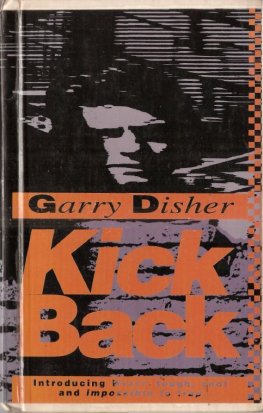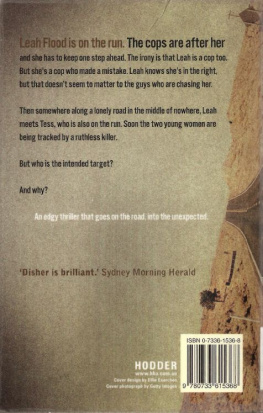FIRST CLASS

FIRST
CLASS
Women Join the Ranks
at the Naval Academy
SHARON HANLEY DISHER

BLUEJACKET BOOKS
NAVAL INSTITUTE PRESS
Annapolis, Maryland
The latest edition of this work has been brought to publication with the generous assistance of Marguerite and Gerry Lenfest.
Naval Institute Press
291 Wood Road
Annapolis, MD 21402
1998 by Sharon Hanley Disher
All rights reserved. No part of this book may be reproduced or utilized in any form or by any means, electronic or mechanical, including photocopying and recording, or by any information storage and retrieval system, without permission in writing from the publisher.
First Bluejacket Books printing, 2005
ISBN 978-1-61251-429-1 (eBook)
The Library of Congress has cataloged the hardcover edition as follows:
Disher, Sharon Hanley, 1958
First class : women join the ranks at the Naval Academy / Sharon Hanley Disher.
p. cm.
1. United States Naval Academy. 2. United States. NavyWomen. I. Title.
V415.P1D57 1998
359.0071173DC21
97-51652
 Print editions meet the requirements of ANSI/NISO z39.48-1992 (Permanence of Paper).
Print editions meet the requirements of ANSI/NISO z39.48-1992 (Permanence of Paper).
9 8 7 6 5 4
To Tim, my inspiration...
... and to the three most patient children in the world, Alison, Brett, and Matthew
Believe in yourself
CONTENTS
Someday you can write a book, my mother told me weeks before I entered Halsey Field House at the United States Naval Academy on 6 July 1976. She urged me to keep a journal and write in it every day. I knew she was right, but I never made the time. Nevertheless, I made a promise to myself that someday I would write that book.
After graduation, I packed up memorabilia that I hoped would one day help me recollect the events of those four years. As time moved on, I routinely watched the bookstores, confident that some other woman graduate would beat me to the publishing punch. Oddly enough, years passed, and no books from the first women appeared on the shelves.
At Homecoming in 1992 I heard stories of women midshipmen with eating disorders and of continued nonacceptance by their male classmates. How could this be? I wondered. It had been sixteen years since women were admitted to the Naval Academy. How could the same problems we faced still be surfacing at such a highly esteemed institution? Had the harassment we suffered all been for naught? I was disturbed and energized. I hoped that what I was hearing was the same type of rumor that had permeated Bancroft Hall when I was a midshipman. The time had come for our story to be tolda story about the first class of women to graduate from the Naval Academy.
A survey that I sent to all the women in my class questioning the need to write this book evoked an overwhelming Yes! Anecdotal stories poured forth from a number of them. Others remained silent. It was not until I approached one of my dearest friends from the Academy that I understood their apprehension.
Reliving those four years was too difficultalmost impossible for some. The scars were too deep, the skeletons too painful to drag out of the closet, even sixteen years later. What could be so bad? I remembered the taunts and the insults. I remembered the defeminizing uniforms and haircuts. But I love the Naval Academy. I always have and always will. It reinforced in me self-confidence, leadership, and assertiveness. What could have happened to these women to silence them?
And then we got together at a reunion in 1993. More told me their stories and gave me permission to include them.
The following story is true. Real names have generally been changed to protect individual privacy, innocence, or guilt. The names of publicly recognizable individualssuch as the Academy superintendent, the Marine Corps commandant, and the chief of naval operations, as well as James Webb and Heinz Lenzhave not been changed; however, Mildred Dietrich is a pseudonym. Reconstructed conversations are based on contemporaneous journals, letters, interviews, and recollections. Some dates are approximations. One of the two main characters is real. The other is a composite based on several female classmates. Everything that happens to her in this book happened to one of the women of 80; minor characters associated with her are based on real individuals. (Originally there was another main character based on an individual who is still on active duty. When I called her to schedule a final interview, she expressed sincere regret that she could no longer be part of the story. She feared that her career in the navy, which is going well, would be jeopardized. And so that character was deleted.) As points of correctness, there were no women from the Class of 1980 in Seventh Company, and there was a female regimental commander for Second Set, plebe-summer detail, 1979, not First Set.
It pains me every time I see a newspaper headline defaming the Naval Academy. It is not my intent to inflict more pain. I write this book to document history. The events depicted in this book took place nearly thirty years ago. If the issues seem too fresh or the events appear too similar to modern-day occurrences, then it is time to stop repeating them.
No author is alone when endeavoring to complete a literary work. I relied on the love, encouragement, and assistance of numerous individuals to help me turn my manuscript into a book. For the part they played in making my dream a reality, I thank the following special people.
For their love, encouragement, and support: Jan and Ed Hanley, Grams and Bump, JJ, Todd, and Chris, Jane and John Disher, and other members of my familymost especially, my wonderful children and husband.
For getting me started: Paula James.
For their stories, patience, and/or best wishes: Kathy Slevin Rondeau, Charlie and Patti Meyers, Peggy Feldmann, Marjorie Morley Bachman, Elizabeth Belzer Rowe, Bill Stulb, Tina DErcole Jaskot, Pam Wacek Svendsen, Carol Burbage, Mark Breckenridge, Dave Kish, Doug Heimbach, Mike Hawley, Sarah McGann, Joe Grace, Pat and Mary Ann Lefler, Susan Welch, Jennifer Smith Holzapfel, Sandy and Willie Taylor, Kathy Shanebrook Garcia, Kathy Karlson Ozimek, Nancy Burke Sullenger, Susan Stapler Cabral, Susan Cox Unger, and Jennifer Schulze.
For their friendship and editorial expertise: Mary Collins Dietrich, Billie Spencer, Sarah Johnson, Jean Ebbert, Diane Willard, Cliff Credle, Trisha Resevic, and Mark Gatlin.
For being the best company in the brigade: the Thirty-third Herd.
For never giving up: the women of the Class of 1980. It is my wish that each of you find a bit of yourself in this book, and that you allow the healing process to finally begin.
Next page












 Print editions meet the requirements of ANSI/NISO z39.48-1992 (Permanence of Paper).
Print editions meet the requirements of ANSI/NISO z39.48-1992 (Permanence of Paper).